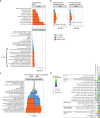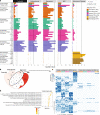Genetic variants associated with psychiatric disorders are enriched at epigenetically active sites in lymphoid cells
- PMID: 36243721
- PMCID: PMC9569335
- DOI: 10.1038/s41467-022-33885-7
Genetic variants associated with psychiatric disorders are enriched at epigenetically active sites in lymphoid cells
Abstract
Multiple psychiatric disorders have been associated with abnormalities in both the innate and adaptive immune systems. The role of these abnormalities in pathogenesis, and whether they are driven by psychiatric risk variants, remains unclear. We test for enrichment of GWAS variants associated with multiple psychiatric disorders (cross-disorder or trans-diagnostic risk), or 5 specific disorders (cis-diagnostic risk), in regulatory elements in immune cells. We use three independent epigenetic datasets representing multiple organ systems and immune cell subsets. Trans-diagnostic and cis-diagnostic risk variants (for schizophrenia and depression) are enriched at epigenetically active sites in brain tissues and in lymphoid cells, especially stimulated CD4+ T cells. There is no evidence for enrichment of either trans-risk or cis-risk variants for schizophrenia or depression in myeloid cells. This suggests a possible model where environmental stimuli activate T cells to unmask the effects of psychiatric risk variants, contributing to the pathogenesis of mental health disorders.
© 2022. The Author(s).
Conflict of interest statement
E.T.B. serves as a member of the scientific advisory boards of Sosei Heptares, Boehringer Ingelheim, Monument Therapeutics, and the Brain & Behavior Research Foundation, and as a consultant for GlaxoSmithKline; he is also a Deputy Editor of
Figures





References
Publication types
MeSH terms
Grants and funding
LinkOut - more resources
Full Text Sources
Medical
Research Materials

